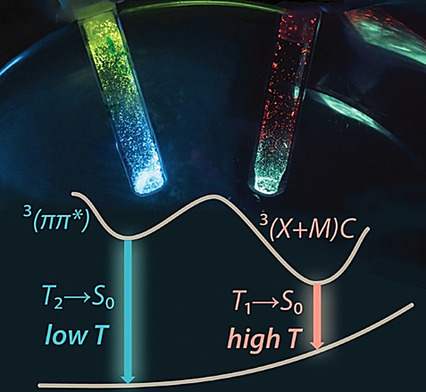Репрезентативные публикации за февраль 2018 г.
S. Heinl, A. Y. Timoshkin, J. Müller, M. Scheer Unexpected differences in the reactivity between the phosphorus and arsenic derivatives [(CpBIGFe)2(µ,η4:4-E4)] (E = P and As), Chem. Commun., 2018, 54, 2244-2247
Статья посвящена исследованию структуры и реакционной спсобности комплексов [{CpBIGFe(CO)2}2(μ,η1:1-E4)] E=P,As). Показано, что при фотолизе происходит удаление СО с образованием двухпалубных сэндвичевых комплексов [(CpBIGFe)2(μ,η4:4-Е4)], причем структуры комплексов фософора и мышьяка существенно различаются.
Abstract

N. Glebko, Thuy Minh Dau, A.S. Melnikov, E.V. Grachova, I.V. Solovyev, A. Belyaev, A.J. Karttunen and I.O. Koshevoy Luminescence thermochromism of gold(I) phosphane-iodide complexes: a rule or an exception? Chem. Eur. J., 2018, 24, 3021–3029.
С использованием политопных лигандов, несущих «мягкую» фосфорную и «жесткую» кислородную функции, была синтезирована серия биядерных комплексных соединений Au(I). Все соединения этой серии полностью охарактеризованы при помощи спектроскопии ЯМР, в том числе с использованием 2D методик, элементного анализа и монокристального РСА. Полученные соединения являются яркими люминофорами в твердой фазе с широкими полосами эмиссии, максимум которых лежит в районе 450–600 нм. Большой Стоксовский сдвиг и зависимость времени жизни люминесценции от кислорода подтверждает преимущественно триплетный характер эмиссии. Было обнаружено, что параметры эмиссии (квантовые выходы и времена жизни возбужденных состояний) соединений зависят от температуры.
Abstract
 A series of gold(I) iodide complexes 1–11 have been prepared from di-, tri-, and tetraphosphane ligands. Crystallographic studies reveal that the di- (1–7) and tetrametallic (11) compounds feature linearly coordinated gold(I) ions with short aurophilic contacts. Their luminescence behavior is determined by the combined influence of the phosphane properties, metal–metal interaction, and intermolecular lattice-defined interactions. The proposed variable contribution of 3(X+M)-centered (X=halogen; M=metal) and 3XLCT (halogen to ligand charge transfer) electronic transitions into the lowest lying excited state, which is influenced by supramolecular packing, is presumably responsible for the alteration of room-temperature emission color from green (λ=545 nm, for 11) to near-IR (λ=698 nm, for 2). Dinuclear compounds 6 and 7 exhibit distinct luminescence thermochromism with a blueshift up to 5750 cm−1 upon cooling. Such dramatic change of emission energy is assigned to the presence of two coupled triplet excited states of 3ππ* and 3(X+M)C/3XLCT nature, the presence of which depends on both molecular structure and the crystal lattice arrangement.
A series of gold(I) iodide complexes 1–11 have been prepared from di-, tri-, and tetraphosphane ligands. Crystallographic studies reveal that the di- (1–7) and tetrametallic (11) compounds feature linearly coordinated gold(I) ions with short aurophilic contacts. Their luminescence behavior is determined by the combined influence of the phosphane properties, metal–metal interaction, and intermolecular lattice-defined interactions. The proposed variable contribution of 3(X+M)-centered (X=halogen; M=metal) and 3XLCT (halogen to ligand charge transfer) electronic transitions into the lowest lying excited state, which is influenced by supramolecular packing, is presumably responsible for the alteration of room-temperature emission color from green (λ=545 nm, for 11) to near-IR (λ=698 nm, for 2). Dinuclear compounds 6 and 7 exhibit distinct luminescence thermochromism with a blueshift up to 5750 cm−1 upon cooling. Such dramatic change of emission energy is assigned to the presence of two coupled triplet excited states of 3ππ* and 3(X+M)C/3XLCT nature, the presence of which depends on both molecular structure and the crystal lattice arrangement.
Stefanie Schlicht, Sandra Haschke, Vladimir Mikhailovskii, Alina Manshina, Julien Bachmann Highly Reversible Water Oxidation at Ordered Nanoporous Iridium Electrodes Based on an Original Atomic Layer Deposition, ChemElectroChem 2018
Впервые созданы нанопористые иридиевые электроды и исследована их электрохимическая активность для реакции окисления воды (выделения кислорода). Электроды представляют собой нанопористый анодированный алюминий, с морфологией прямых цилиндрических нанопор. Стенки нанопор с помощью атомно-слоевого осаждения покрыты металлическим слоем иридия. Продемонстрировано, что такие электроды обеспечивают достижение умеренных плотностей тока при очень низких перенапряжениях, что делает такие электроды перспективными для создания аккумуляторов с высокой степенью реверсивности.
Abstract

Nanoporous iridium electrodes are prepared and electrochemically investigated towards the water oxidation (oxygen evolution) reaction. The preparation is based on ‘anodic’ aluminum oxide templates, which provide straight, cylindrical nanopores. Their walls are coated using atomic layer deposition (ALD) with a newly developed reaction which results in a metallic iridium layer. The ALD film growth is quantified by spectroscopic ellipsometry and X-ray reflectometry. The morphology and composition of the electrodes are characterized by scanning electron microscopy, energy-dispersive X-ray spectroscopy, and X-ray diffraction. Their catalytic activity is quantified for various pore geometries by cyclic voltammetry, steady-state electrolysis, and electrochemical impedance spectroscopy. With an optimal pore length of L≈17–20 μm, we achieve current densities of J=0.28 mA cm−2 at pH 5 and J=2.4 mA cm−2 at pH 1. This platform is particularly competitive for achieving moderate current densities at very low overpotentials, that is, for a high degree of reversibility in energy storage.


